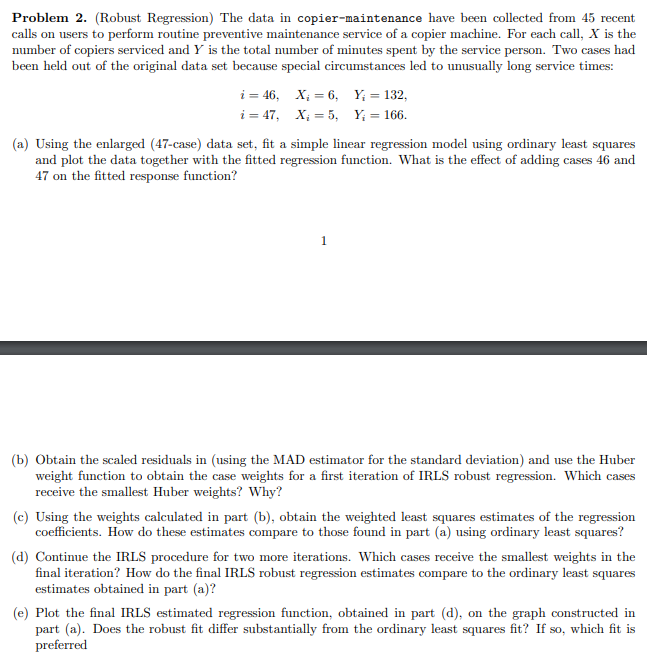
Problem 2. (Robust Regression) The data in copier-maintenance have been collected from 45 recent calls on users to perform routine preventive maintenance service of a copier machine. For each call, X is the number of copiers serviced and Y is the total number of minutes spent by the service person. Two cases had been held out of the original data set because special circumstances led to unusually long service times: i=46,i=47,Xi=6,Xi=5,Yi=132,Yi=166. (a) Using the enlarged (47-case) data set, fit a simple linear regression model using ordinary least squares and plot the data together with the fitted regression function. What is the effect of adding cases 46 and 47 on the fitted response function? (b) Obtain the scaled residuals in (using the MAD estimator for the standard deviation) and use the Huber weight function to obtain the case weights for a first iteration of IRLS robust regression. Which cases receive the smallest Huber weights? Why? (c) Using the weights calculated in part (b), obtain the weighted least squares estimates of the regression coefficients. How do these estimates compare to those found in part (a) using ordinary least squares? (d) Continue the IRLS procedure for two more iterations. Which cases receive the smallest weights in the final iteration? How do the final IRLS robust regression estimates compare to the ordinary least squares estimates obtained in part (a)? (e) Plot the final IRLS estimated regression function, obtained in part (d), on the graph constructed in part (a). Does the robust fit differ substantially from the ordinary least squares fit? If so, which fit is preferred Problem 2. (Robust Regression) The data in copier-maintenance have been collected from 45 recent calls on users to perform routine preventive maintenance service of a copier machine. For each call, X is the number of copiers serviced and Y is the total number of minutes spent by the service person. Two cases had been held out of the original data set because special circumstances led to unusually long service times: i=46,i=47,Xi=6,Xi=5,Yi=132,Yi=166. (a) Using the enlarged (47-case) data set, fit a simple linear regression model using ordinary least squares and plot the data together with the fitted regression function. What is the effect of adding cases 46 and 47 on the fitted response function? (b) Obtain the scaled residuals in (using the MAD estimator for the standard deviation) and use the Huber weight function to obtain the case weights for a first iteration of IRLS robust regression. Which cases receive the smallest Huber weights? Why? (c) Using the weights calculated in part (b), obtain the weighted least squares estimates of the regression coefficients. How do these estimates compare to those found in part (a) using ordinary least squares? (d) Continue the IRLS procedure for two more iterations. Which cases receive the smallest weights in the final iteration? How do the final IRLS robust regression estimates compare to the ordinary least squares estimates obtained in part (a)? (e) Plot the final IRLS estimated regression function, obtained in part (d), on the graph constructed in part (a). Does the robust fit differ substantially from the ordinary least squares fit? If so, which fit is preferred







